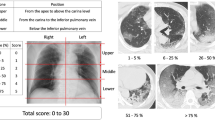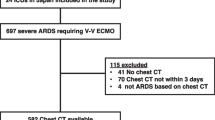Abstract
VA-ECMO is a promising therapeutic option in refractory cardiogenic shock (RCS) and refractory cardiac arrest (RCA). However, increase in left ventricular afterload enhances further reduction of LV contractility and pulmonary edema. The aim of this study was to evaluate pulmonary edema based on the RALE score and the prognostic value of the score on ECLS weaning and mortality. In this retrospective study, data from 40 patients (16 RCAs and 24 RCSs) were analyzed. Demographic, clinical data and the RALE score for evaluating pulmonary edema were assessed. Descriptive statistics, intraclass correlation, and receiver operating characteristic (ROC) curves were computed. Weaning from ECLS was successful in 30 (75%) patients, 16 patients (40%) were discharged alive. Overall, the survivors were younger, presenting with a higher left ventricular ejection fraction (30 ± 2% vs.23 ± 9%;p < 0.01) and a lower initial serum lactate concentration 7.7 ± 4.5 mmol/l vs. 11.5 ± 4.9 mmol/l; p = 0.017). Survivors had lower RALE scores than non-survivors (16.3 ± 9.4 vs. 26.4 ± 10.4; p = 0.0034). The interobserver variability of the RALE score was good (0.832). The AUC predicting mortality and weaning from ECLS presented comparable results to the established parameters (SAVE, serum lactate). Implementation of the RALE score could support prediction of outcome parameters during VA-ECMO therapy.


Similar content being viewed by others
References
Puymirat E, Simon T, Cayla G et al (2017) Acute myocardial infarction: changes in patient characteristics, management, and 6-month outcomes over a period of 20 years in the FAST-MI program (French Registry of Acute ST-elevation or Non-ST-elevation myocardial infarction) 1995 to 2015. Circulation 136:1908–1919. https://doi.org/10.1161/CIRCULATIONAHA.117.030798
Neumann JT, Goßling A, Sörensen NA et al (2020) Temporal trends in incidence and outcome of acute coronary syndrome. Clin Res Cardiol Off J Ger Card Soc 109:1186–1192. https://doi.org/10.1007/s00392-020-01612-1
Yandrapalli S, Sanaani A, Harikrishnan P et al (2019) Cardiogenic shock during heart failure hospitalizations: age-, sex-, and race-stratified trends in incidence and outcomes. Am Heart J 213:18–29. https://doi.org/10.1016/j.ahj.2019.03.015
Lauridsen MD, Rørth R, Lindholm MG et al (2020) Trends in first-time hospitalization, management, and short-term mortality in acute myocardial infarction-related cardiogenic shock from 2005 to 2017: a nationwide cohort study. Am Heart J 229:127–137. https://doi.org/10.1016/j.ahj.2020.08.012
Asleh R, Resar JR (2019) Utilization of percutaneous mechanical circulatory support devices in cardiogenic shock complicating acute myocardial infarction and high-risk percutaneous coronary interventions. J Clin Med. https://doi.org/10.3390/jcm8081209
Cove ME, MacLaren G (2010) Clinical review: mechanical circulatory support for cardiogenic shock complicating acute myocardial infarction. Crit Care Lond Engl 14:235. https://doi.org/10.1186/cc9229
Ali JM, Abu-Omar Y (2020) Complications associated with mechanical circulatory support. Ann Transl Med 8:835–835. https://doi.org/10.21037/atm.2020.03.152
Subramaniam AV, Barsness GW, Vallabhajosyula S, Vallabhajosyula S (2019) Complications of temporary percutaneous mechanical circulatory support for cardiogenic shock: an appraisal of contemporary literature. Cardiol Ther 8:211–228. https://doi.org/10.1007/s40119-019-00152-8
Hilty MP, Franzen DP, Wyss C et al (2017) Validation of transpulmonary thermodilution variables in hemodynamically stable patients with heart diseases. Ann Intensive Care 7:86. https://doi.org/10.1186/s13613-017-0307-0
Monnet X, Teboul J-L (2017) Transpulmonary thermodilution: advantages and limits. Crit Care Lond Engl 21:147. https://doi.org/10.1186/s13054-017-1739-5
Pohl T, Kozieras J, Sakka SG (2008) Influence of extravascular lung water on transpulmonary thermodilution-derived cardiac output measurement. Intensive Care Med 34:533–537. https://doi.org/10.1007/s00134-007-0916-4
Ware LB, Neyrinck A, O’Neal HR et al (2012) Comparison of chest radiograph scoring to lung weight as a quantitative index of pulmonary edema in organ donors. Clin Transplant 26:665–671. https://doi.org/10.1111/j.1399-0012.2011.01591.x
Warren MA, Zhao Z, Koyama T et al (2018) Severity scoring of lung edema on the chest radiograph is associated with clinical outcomes in ARDS. Thorax 73:840–846. https://doi.org/10.1136/thoraxjnl-2017-211280
Collet J-P, Thiele H, Barbato E et al (2021) 2020 ESC Guidelines for the management of acute coronary syndromes in patients presenting without persistent ST-segment elevation: the Task Force for the management of acute coronary syndromes in patients presenting without persistent ST-segment elevation of the European Society of Cardiology (ESC). Eur Heart J 42:1289–1367. https://doi.org/10.1093/eurheartj/ehaa575
Panchal AR, Bartos JA, Cabañas JG et al (2020) Part 3: Adult basic and advanced life support: 2020 American Heart Association Guidelines for cardiopulmonary resuscitation and emergency cardiovascular care. Circulation 142:S366–S468. https://doi.org/10.1161/CIR.0000000000000916
Murray JF, Matthay MA, Luce JM, Flick MR (1988) An expanded definition of the adult respiratory distress syndrome. Am Rev Respir Dis 138:720–723. https://doi.org/10.1164/ajrccm/138.3.720
Schmidt M, Burrell A, Roberts L et al (2015) Predicting survival after ECMO for refractory cardiogenic shock: the survival after veno-arterial-ECMO (SAVE)-score. Eur Heart J 36:2246–2256. https://doi.org/10.1093/eurheartj/ehv194
Bernhard M, Döll S, Kramer A et al (2020) Elevated admission lactate levels in the emergency department are associated with increased 30-day mortality in non-trauma critically ill patients. Scand J Trauma Resusc Emerg Med 28:82. https://doi.org/10.1186/s13049-020-00777-y
Porto I, Mattesini A, D’Amario D et al (2021) Blood lactate predicts survival after percutaneous implantation of extracorporeal life support for refractory cardiac arrest or cardiogenic shock complicating acute coronary syndrome: insights from the CareGem registry. Intern Emerg Med 16:463–470. https://doi.org/10.1007/s11739-020-02459-0
Scolari FL, Schneider D, Fogazzi DV et al (2020) Association between serum lactate levels and mortality in patients with cardiogenic shock receiving mechanical circulatory support: a multicenter retrospective cohort study. BMC Cardiovasc Disord 20:496. https://doi.org/10.1186/s12872-020-01785-7
Laurikkala J, Skrifvars MB, Bäcklund M et al (2019) Early lactate values after out-of-hospital cardiac arrest: associations with one-year outcome. Shock 51:168–173. https://doi.org/10.1097/SHK.0000000000001145
Herner A, Lahmer T, Mayr U et al (2020) Transpulmonary thermodilution before and during veno-venous extra-corporeal membrane oxygenation ECMO: an observational study on a potential loss of indicator into the extra-corporeal circuit. J Clin Monit Comput 34:923–936. https://doi.org/10.1007/s10877-019-00398-6
Enghard P, Rademacher S, Nee J et al (2015) Simplified lung ultrasound protocol shows excellent prediction of extravascular lung water in ventilated intensive care patients. Crit Care 19:36. https://doi.org/10.1186/s13054-015-0756-5
Mayr U, Lukas M, Habenicht L et al (2022) B-lines scores derived from lung ultrasound provide accurate prediction of extravascular lung water index: an observational study in critically ill patients. J Intensive Care Med 37:21–31. https://doi.org/10.1177/0885066620967655
Picano E, Pellikka PA (2016) Ultrasound of extravascular lung water: a new standard for pulmonary congestion. Eur Heart J 37:2097–2104. https://doi.org/10.1093/eurheartj/ehw164
Price S, Platz E, Cullen L et al (2017) Echocardiography and lung ultrasonography for the assessment and management of acute heart failure. Nat Rev Cardiol 14:427–440. https://doi.org/10.1038/nrcardio.2017.56
Frassi F, Gargani L, Tesorio P et al (2007) Prognostic value of extravascular lung water assessed with ultrasound lung comets by chest sonography in patients with dyspnea and/or chest pain. J Card Fail 13:830–835. https://doi.org/10.1016/j.cardfail.2007.07.003
Su Y, Liu K, Zheng J-L et al (2020) Hemodynamic monitoring in patients with venoarterial extracorporeal membrane oxygenation. Ann Transl Med 8:792–792. https://doi.org/10.21037/atm.2020.03.186
Douflé G, Roscoe A, Billia F, Fan E (2015) Echocardiography for adult patients supported with extracorporeal membrane oxygenation. Crit Care 19:326. https://doi.org/10.1186/s13054-015-1042-2
Halperin BD, Feeley TW, Mihm FG et al (1985) Evaluation of the portable chest roentgenogram for quantitating extravascular lung water in critically ill adults. Chest 88:649–652. https://doi.org/10.1378/chest.88.5.649
Wernly B, Haumann S, Masyuk M et al (2018) Extravascular lung water index and Halperin score to predict outcome in critically ill patients. Wien Klin Wochenschr 130:505–510. https://doi.org/10.1007/s00508-018-1370-8
Lemson J, van Die LE, Hemelaar AEA, van der Hoeven JG (2010) Extravascular lung water index measurement in critically ill children does not correlate with a chest x-ray score of pulmonary edema. Crit Care Lond Engl 14:R105. https://doi.org/10.1186/cc9054
Marasco SF, Lukas G, McDonald M et al (2008) Review of ECMO (extra corporeal membrane oxygenation) support in critically ill adult patients. Heart Lung Circ 17(Suppl 4):S41-47. https://doi.org/10.1016/j.hlc.2008.08.009
Lim HS, Howell N, Ranasinghe A (2017) Extracorporeal life support: physiological concepts and clinical outcomes. J Card Fail 23:181–196. https://doi.org/10.1016/j.cardfail.2016.10.012
Roumy A, Liaudet L, Rusca M et al (2020) Pulmonary complications associated with veno-arterial extra-corporeal membrane oxygenation: a comprehensive review. Crit Care Lond Engl 24:212. https://doi.org/10.1186/s13054-020-02937-z
Nolan JP, Sandroni C, Böttiger BW et al (2021) European resuscitation council and european society of intensive care medicine guidelines 2021: post-resuscitation care. Resuscitation 161:220–269. https://doi.org/10.1016/j.resuscitation.2021.02.012
Besnier E, Boubèche S, Clavier T et al (2020) Early positive fluid balance is associated with mortality in patients treated with veno-arterial extra corporeal membrane oxygenation for cardiogenic shock: a retrospective cohort study. Shock 53:426–433. https://doi.org/10.1097/SHK.0000000000001381
Xie A, Forrest P, Loforte A (2019) Left ventricular decompression in veno-arterial extracorporeal membrane oxygenation. Ann Cardiothorac Surg 8:9–18. https://doi.org/10.21037/acs.2018.11.07
Schrage B, Becher PM, Bernhardt A et al (2020) Left ventricular unloading is associated with lower mortality in patients with cardiogenic shock treated with venoarterial extracorporeal membrane oxygenation: results from an international, multicenter cohort study. Circulation 142:2095–2106. https://doi.org/10.1161/CIRCULATIONAHA.120.048792
Richardson AC, Tonna JE, Nanjayya V et al (2021) Extracorporeal cardiopulmonary resuscitation in adults. interim guideline consensus statement from the extracorporeal life support organization. ASAIO J 67:221–228. https://doi.org/10.1097/MAT.0000000000001344
Kang D-H, Kim J, Rhee JE et al (2015) The risk factors and prognostic implication of acute pulmonary edema in resuscitated cardiac arrest patients. Clin Exp Emerg Med 2:110–116. https://doi.org/10.15441/ceem.14.016
Jang SJ, Cha YK, Kim JS et al (2020) Computed tomographic findings of chest injuries following cardiopulmonary resuscitation: more complications for prolonged chest compressions? Med (Baltim) 99:e21685. https://doi.org/10.1097/MD.0000000000021685
Cho SH, Kim EY, Choi SJ et al (2013) Multidetector CT and radiographic findings of lung injuries secondary to cardiopulmonary resuscitation. Injury 44:1204–1207. https://doi.org/10.1016/j.injury.2012.10.004
Author information
Authors and Affiliations
Contributions
IV: Conceptualization, methodology, investigation, writing—original draft, writing—review and editing, visualization. MM, DM, PA: Investigation, writing—review and editing. OB: Writing—review and editing, supervision.
Corresponding author
Ethics declarations
Conflict of interests
The authors declare that there is no conflict of interest regarding the publication of this article.
Ethical approval
Ethical approval was waived by the Ethics Committee of the regional Medical Association (North-Rhine; Nr.20210506) in view of the retrospective nature of the study and all the procedures being performed were part of the routine care.
Informed consent
For this type of study formal consent is not required.
Additional information
Publisher's Note
Springer Nature remains neutral with regard to jurisdictional claims in published maps and institutional affiliations.
Rights and permissions
About this article
Cite this article
Voigt, I., Mighali, M., Manda, D. et al. Radiographic assessment of lung edema (RALE) score is associated with clinical outcomes in patients with refractory cardiogenic shock and refractory cardiac arrest after percutaneous implantation of extracorporeal life support. Intern Emerg Med 17, 1463–1470 (2022). https://doi.org/10.1007/s11739-022-02937-7
Received:
Accepted:
Published:
Issue Date:
DOI: https://doi.org/10.1007/s11739-022-02937-7




